Ranking things is a time-honoured tradition in human history. It’s as old as numbers themselves.
Did you know that the very first tally marks recorded on sticks and bones were used to rank prehistoric humans' favourite foods in their paleo diet? And that ancient Sumerians ranked their top ten gods on cuneiform tablets? And don’t forget that Brahmagupta invented “zero” when he was ranking his favourite mathematicians but forgot himself, so ranked himself above number one, simultaneously inventing the phrase “zero the hero.”
Those things are almost definitely not true, but they have an air of truthiness to them, which is almost as good.
It’s time to join this proud and ancient historical tradition by ranking the Vancouver Canucks’ top prospects using another piece of ancient history: the noble pyramid.
The Prospect Pyramid, a concept shamelessly stolen from professional yeller Steve Dangle, does away with the numbered list that is so typical of draft rankings, and replaces it with a two-dimensional triangle that is inaccurately called a “pyramid” for the sake of alliteration.
The prospects are ranked in tiers, which naturally lends itself to a triangular shape, as a prospect pool has fewer top prospects and a wealth of prospects with more limited potential. This results in less splitting of hairs trying to determine the difference between the 7th and 8th best prospect or the 19th and 20th best.
For this year’s edition of the prospect pyramid, we’re setting the age limit on being a prospect at 24, so if they turn 25 before the start of the season, they’re off the pyramid. That counts out Linus Karlsson, Nils Åman, Max Sasson, Nikita Tolopilo, and Jett Woo.
That doesn’t mean players like Karlsson and Sasson don’t have potential to play in the NHL — they certainly do — but more of an acknowledgement that we have a good idea of who they are as players and still calling them a prospect is a stretch.
With that caveat out of the way, let’s dive in.
Tier 1 - Nobody
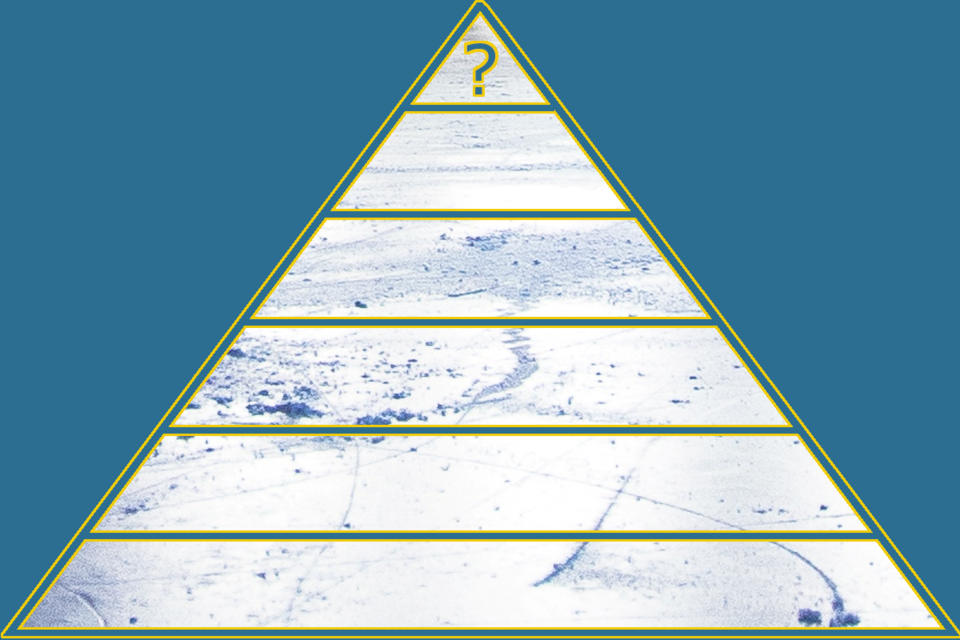
The top tier of the pyramid is for blue-chip, can’t-miss prospects. We’re talking about players who are a lock to not only make the NHL, but are also likely to be stars: a first-line forward, top-pairing defenceman, or number one goaltender with franchise potential.
This is the tier for the likes of Elias Pettersson, Quinn Hughes, and Thatcher Demko. Unfortunately, the Canucks don’t have anyone of that caliber in their system right now.
That’s not too surprising, really. The Canucks have traded away three of their last six first-round picks and their remaining first-round picks have all come outside of the top ten.
The closest to fitting in this tier is Tom Willander, who has a chance to be a top-pairing defenceman, but isn’t quite a blue-chip future all-star.
Tier 2 - Willander, Cootes, and Lekkerimäki
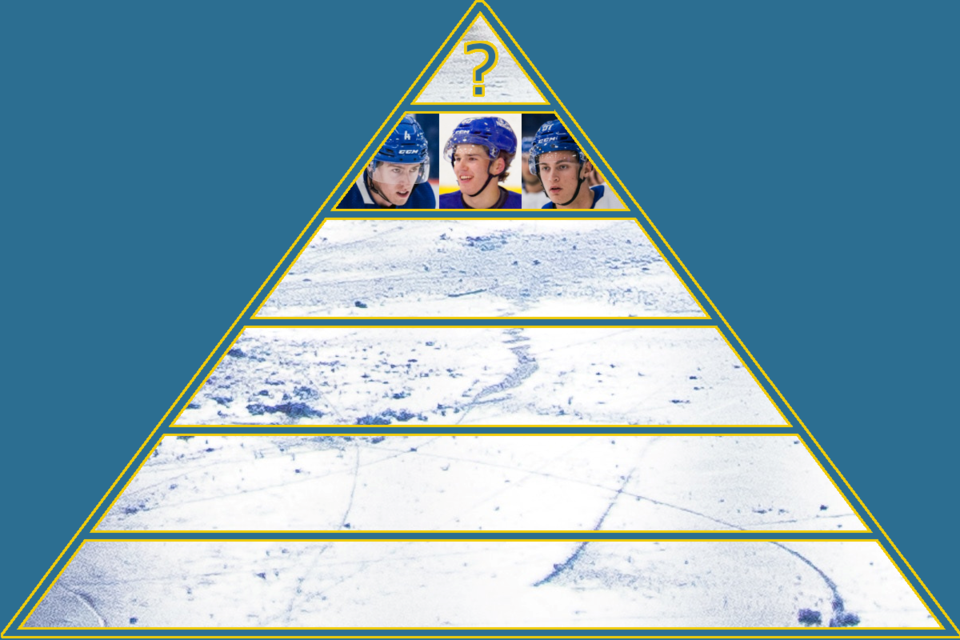
In the second tier, we get our prospects with the potential to be a top-four defenceman, a top-six forward, or a starting goaltender, and a strong chance of reaching that potential. If everything goes right, maybe they could even be a legitimate star, but the odds of reaching that potential are a bit lower than a tier-one prospect.
The Canucks may not have any top-tier prospects, but they have three that fit into the second tier.
Tom Willander
Tom Willander is the closest to a sure thing in the Canucks’ prospect pool. The smooth-skating Swede has all the hallmarks of a defenceman who will patrol an NHL blue line for a decade in a top-four role.
Defensively, Willander plays the type of modern, mobile shutdown game that could make him a candidate to match up against top forwards on the opposition. If all goes well, he could become the type of minute-munching, right-shot defenceman that NHL teams beg to have in their lineup.
The big question for Willander is whether he can bring an offensive dimension to his game in the NHL, as his puck skills are less refined than his play away from the puck. It’s not just a question of whether he’ll be a top-pairing star, but whether he can move the puck effectively enough to be a complementary player on a top pairing.
Given his work ethic and professionalism, I wouldn’t bet against Willander reaching his ceiling. But those lingering doubts bump him down to Tier 2.
Braeden Cootes
Most draft pundits project that Braeden Cootes, the Canucks’ 15th-overall pick from the 2025 NHL Entry Draft, will be a third-line centre. That would typically be the realm of a Tier 3 prospect, but I’ve got higher hopes.
Cootes was a standout at the Canucks’ summer development camp, showcasing a diverse array of skills and a diligent work ethic. There’s a reason the Canucks immediately signed him to a three-year, entry-level contract.
Playing on a Seattle Thunderbirds team that didn’t give him much of a chance to thrive offensively, Cootes likely has a higher upside than his 63 points in 60 WHL games in his draft year would suggest. He has the potential to be a second-line, match-up centre in the future.
Jonathan Lekkerimäki
The fact that Jonathan Lekkerimäki was a healthy scratch at times during the Abbotsford Canucks’ run to the Calder Cup might be a bit of a red flag, but the Swedish winger has shown a knack for bouncing back from those kinds of disappointments.
Lekkerimäki has the best odds of anyone in the Canucks’ system to be a top-six forward, with the type of pure goalscoring ability that is rare even on the Canucks’ current NHL roster. His shot is a weapon, capable of beating even NHL goaltenders from distance, as he showed last season.
Beyond the shot, Lekkerimäki has diversified his skillset in recent years, adding some bite on the forecheck. He’s still on the lighter side and definitely needs to add more strength and weight to his frame to make the jump to the NHL, but he has a knack for winning board battles with smart positioning and a quick stick, frequently coming away with the puck when you wouldn’t expect him to.
But really, it comes down to scoring goals, something he did at a high rate in the AHL last season, tallying 19 goals in just 36 games in the regular season.
Tier 3 - Pettersson and friends
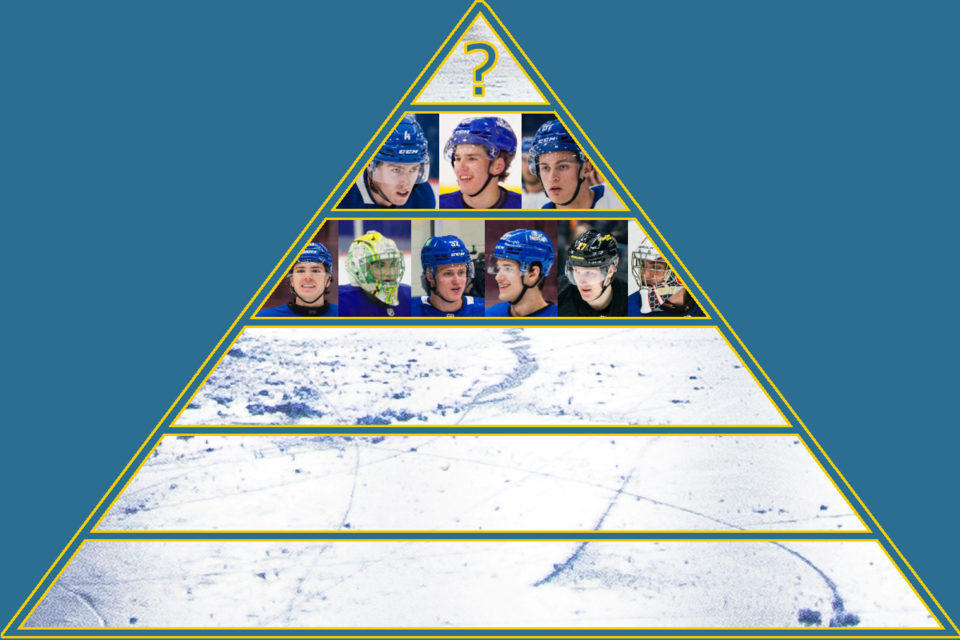
The third tier is for players whose upside leans towards bottom-six forward, third-pairing defenceman, or backup goaltender. Or, if they have a higher ceiling, there’s more boom-or-bust potential than a Tier 2 prospect.
That’s not to say that the prospects in this tier won’t overachieve, but there’s a lot more uncertainty about how good they can be.
Victor Mancini
There’s a lot to like about Victor Mancini, who came to the Canucks as part of the J.T. Miller trade. He’s a big, mobile defenceman who plays a physical defensive game and has shown a little bit of offensive pop with his ability to jump up in the rush. He got into 16 NHL games with the Canucks after the trade and played a major role in the Abbotsford Canucks’ Calder Cup run.
The 23-year-old has the potential to be a big part of the Canucks’ future, but he makes me nervous with some of his reads in the defensive zone. Can he step up his game to make the permanent jump to the NHL? I honestly don’t know.
Aleksei Medvedev
The Canucks wasted no time signing 17-year-old goaltender Aleksei Medvedev to an entry-level contract after selecting him in the second round of the 2025 NHL Entry Draft.
Medvedev is the youngest goaltender in the Canucks’ system by three years and seems to be the team’s most likely Goaltender of the Future™.
That said, Medvedev still has a lot to prove, as he played just 34 games for the London Knights in the OHL last season and has yet to show that he can be a workhorse starting goaltender at that level. Depending on how he performs in the coming season, Medvedev could climb the pyramid, but there’s still some uncertainty with his projection.
Elias Pettersson
The Canucks really like Elias “Junior” Pettersson, as evidenced by them giving him 28 games in the NHL last season, then sending a message that he was an NHLer by not papering him down to the Abbotsford Canucks so he could join the team on their playoff run.
I like him too. He’s a physical defensive defenceman, who showed he can play on either side of the ice in the NHL at the tender age of 21. I’m just not sure if he’ll be more than a third-pairing defenceman.
Some Canucks fans have been quick to pencil Pettersson into a top-four role, but Pettersson was heavily sheltered last season, and I’m a little bit hesitant to assume that he can make the jump to a second-pairing role. I would love to be proven wrong.
Kirill Kudryavtsev
I’ve been high on Kudryavtsev ever since I saw him at his first Canucks development camp after he was drafted in the seventh round in 2022. Even at the age of 18, he had clear pro habits in everything he did on the ice, particularly in the way he layered deception into every pass.
His development since being drafted has been steady and methodical, as he has consistently worked on his weaknesses, leading to a solid rookie season in the AHL with the Abbotsford Canucks, while also getting into two NHL games at the end of the season, where he held his own.
The 20-year-old defenceman put up 26 points in 65 AHL games, then added 10 points in 21 playoff games while leading the playoffs in plus/minus.
Kudryavtsev’s calm and poised two-way game could translate to a bottom-pairing role in the NHL if he gets the opportunity, but he has a lot of competition in the Canucks’ system, and he lacks a true standout skill to separate himself from the pack.
Aatu Räty
Aatu Räty ought to be an NHLer next season. He’s no longer exempt from waivers, and the Canucks have a distinct need at centre. Heck, there’s a chance that he gets an opportunity to be the team’s second-line centre if they don’t find anyone else.
It’s far more likely, however, that Räty finds his niche in the NHL in the bottom-six: a faceoff-winning, penalty-killing centre that can pop in the occasional goal around the net.
This will be a significant season for Räty, who will turn 23 about a month into the season. He should get a major chance to prove himself, but what will he prove to be?
Ty Young
Three years before Medvedev, Ty Young was one of the youngest prospects in his draft, with a September 11 birthday compared to Medvedev’s September 10 birthday.
Young was a fifth-round pick in 2022 and had a lot more uncertainty in his projection when he was drafted, but has progressed well and impressed in the ECHL this past season, posting a .926 save percentage in what can be a pretty chaotic league.
The Canucks are quite high on Young — higher than I am, to be honest. But I can see the potential for Young to be a backup goaltender in the NHL, though he’ll first have to prove himself in the AHL in the coming season.
Tier 4 - Bains and co.
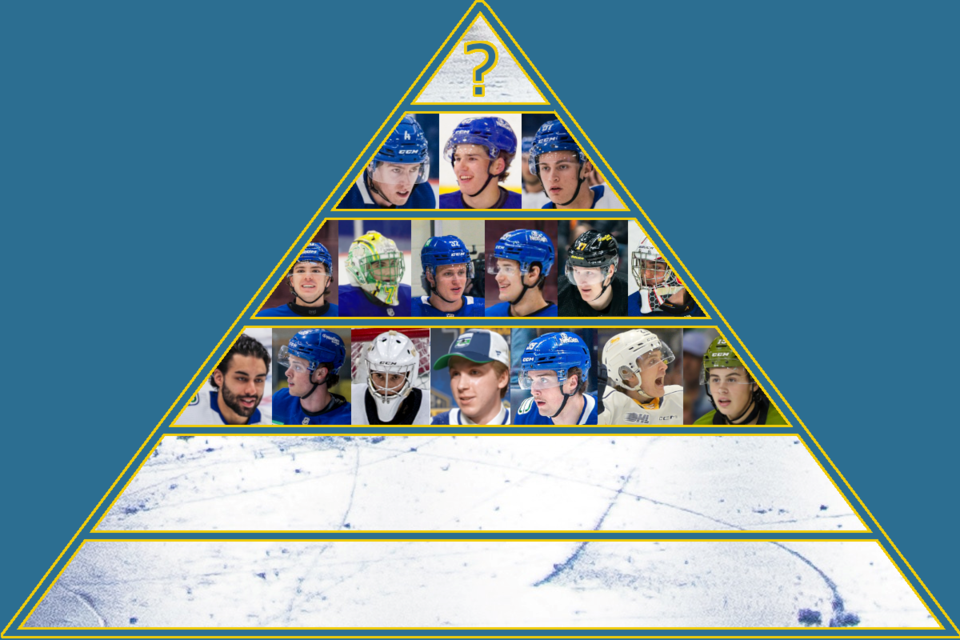
The fourth tier of the prospect pyramid is for prospects whose potential is currently up in the air. Maybe they’ll be a fourth-line forward, a seventh defenceman, or a bubble backup. Maybe they have the potential to be more than that, but they’re less likely to reach that potential than those higher up the pyramid.
It’s all a little unclear.
Arshdeep Bains
Some Canucks fans might question my decision to put Arshdeep Bains in tier 4, especially after he led the Abbotsford Canucks in scoring in the regular season, then put up 24 points in 24 playoff games to help lead the team to the Calder Cup.
The issue is that Bains is already 24 and hasn’t shown any of that scoring upside at the NHL level. In the AHL, Bains is a creative playmaker who can thread passes through traffic to find the open man for grade-A scoring chances. In the NHL, Bains is a generic fourth-liner.
I absolutely think Bains can be a fourth-line forward at the NHL level, but I can’t confidently say he’ll be anything more than that, so he lands in the fourth tier until he proves otherwise.
Kieren Dervin
Kieren Dervin might have the most volatile projection of any prospect in the Canucks’ system.
The Canucks’ third-round pick in the 2025 NHL Entry Draft has some intriguing potential and could have a breakout season in the OHL, but there’s so much uncertainty that keeps him from being in a higher tier on the pyramid.
That’s because Dervin played prep school hockey for St. Andrew’s College rather than major junior. He dominated for St. Andrew’s, putting up 33 goals and 79 points in 50 games, but it’s hard to assess just how good that is given his lower quality of competition.
Aku Koskenvuo
Aku Koskenvuo faltered at Harvard University in his Junior season, posting a .902 save percentage after a .910 save percentage the season before. In fact, he was outperformed by the younger Ben Charette, an undrafted freshman.
Still, there’s a lot to like about Koskenvuo’s size at 6’4” and his athleticism. He’s heading to the Abbotsford Canucks next season, though he’ll be competing with Ty Young and Nikita Tolopilo for playing time and could find himself in the ECHL. It will be a good opportunity to properly gauge the 22-year-old goaltender’s potential.
Sawyer Mynio
I’m a little lower on Sawyer Mynio than others might be, but I’m willing to be proven wrong. At 19 years old, Mynio had a great final season in the WHL, as he put up 45 points in 49 games, split between the Seattle Thunderbirds and Calgary Hitmen.
I’m just not convinced any of that offence will translate to the NHL.
Of course, Mynio’s calling card is his defensive game, and there might be enough there for Mynio to make the NHL, with the solid point totals at least suggesting he can move the puck well, which is a good sign for his NHL potential.
He’ll be joining the Abbotsford Canucks in the AHL in the coming season, where we should get a better sense of where he fits on the Canucks’ depth chart on defence.
Ty Mueller
The Canucks are high on Ty Mueller and believe he has upside as a bottom-six forward. He showed some of that potential in his rookie season in the AHL, putting up 39 points in 64 regular-season games for the Abbotsford Canucks, then 12 points in 24 playoff games.
The 22-year-old forward also got into two late-season gam
Mueller isn’t the most exciting player, but he competes hard, plays a solid defensive game, and has some positional versatility. He can do a bit of everything, which makes it easy to envision him playing some more NHL games next season, albeit in a depth role.
Riley Patterson
Pattersson had fewer points than in his draft year, putting up 25 goals and 59 points, but that was still enough to lead all Barrie Colts forwards in scoring. And the Colts were one of the top teams in the OHL this past season; they were just a little more focused on defence than racking up goals.
When it comes to evaluating Pattersson as a prospect, however, that leaves us on some uncertain ground. Patterson certainly has intriguing tools, with great speed and a deceptive shot, and combines that with a strong defensive game, but it’s a question of whether any of those elements are high-end enough to get him to the NHL.
Anthony Romani
Anthony Romani can certainly score. Even though his OHL season was derailed by injuries, Romani put the puck in the net a bunch when he was healthy, tallying 21 goals in just 35 games.
Romani then capped off his season — and OHL career — with 12 goals and 24 points in 16 playoff games.
With that kind of production, why is Romani in Tier 4? Well, there are some questions about his skating, which is obviously good enough for him to thrive in junior, but could limit him as he faces tougher, faster competition. He’ll also have to prove himself defensively, or he’ll never get the opportunity to prove he can put the puck in the net.
Fortunately, Romani is heading to Michigan State University in the NCAA, where he’ll have a little more time to develop before he jumps to professional hockey. If he keeps scoring in the college ranks, he’ll be jumping up the prospect pyramid in no time.
Tier 5 - Alriksson and pals
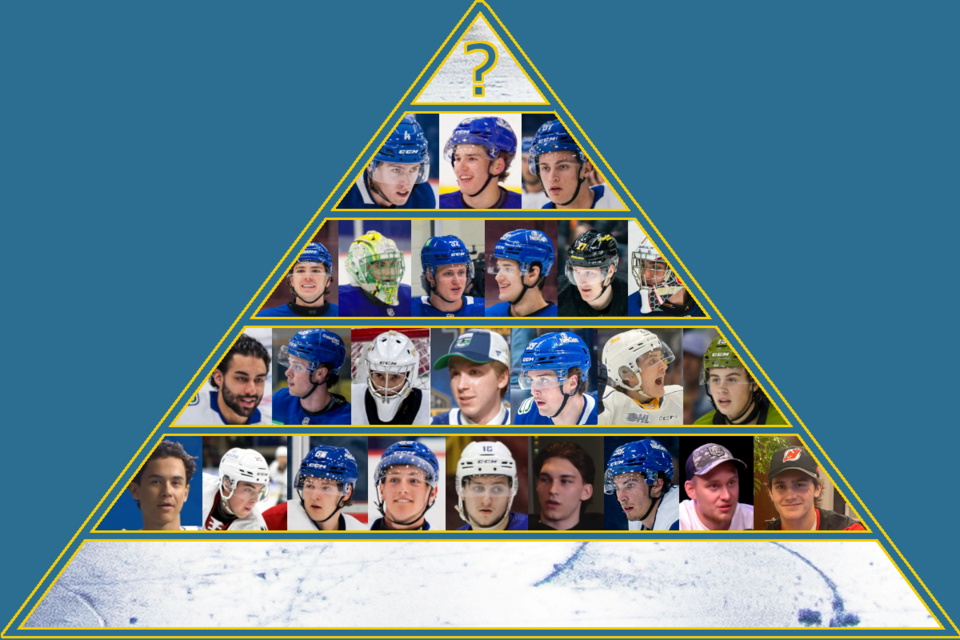
The fifth tier is for prospects whose potential veers in the direction of being a bubble player: a depth forward, depth defenceman, or AHL goaltender. There’s certainly a chance that these players could reach the NHL, but it’s more likely it will be as a call-up rather than a permanent fixture on the roster.
Parker Alcos
There’s a lot to like about Parker Alcos, a right-shot, smooth-skating defensive defenceman with good size at 6’3”.
But Alcos didn’t show much progression in his post-draft year, especially given that he had more opportunities offensively, including time on the power play. He tallied just 1 goal and 13 points in 57 games with the Edmonton Oil Kings, fewer points than in his draft year, albeit in ten fewer games.
That limited production is not a great sign for Alcos’s NHL upside, as even defensive defencemen in the NHL typically put up points in junior. Alcos still has potential, but he’s got a lot of work ahead of him.
Vilmer Alriksson
I actually quite like Vilmer Alriksson, and I was tempted to bump him up to Tier 4, but I can’t justify doing so for a prospect who failed to crack a point-per-game as a 20-year-old winger in the OHL.
There’s just so much raw potential in Alriksson’s game. He’s huge at 6’6” and 234 lbs, but has both smooth skating and smooth hands to go with his frame. If everything comes together, Alriksson could be a true power forward who fits into the middle-six of an NHL lineup, complementing smaller, skilled forwards with his work on the forecheck and in front of the net.
Then again, Alriksson could wind up as a bottom-six forward in the AHL, unable to take the next step in his development. That massive range in possibilities lands him in Tier 5.
Gabe Chiarot
Gabe Chiarot is a diligent two-way forward with the speed, motor, and grit to get in on the forecheck or harass top competition in the defensive zone. He also has decent hands around the net, tallying 21 goals in 66 OHL games in his draft year.
That said, Chiarot only had 35 points and was one of the oldest first-time draft-eligible prospects in the 2025 draft. You can see why the Canucks took a chance on him in the sixth round, as he plays the exact style of game they love, but he has a lot of work ahead of him.
Wilson Björck
Wilson Björck racked up points last season. The only trouble is, he was in his second year of draft eligibility and was still playing in the J20 Nationell, Sweden’s top junior league, rather than against men like other top prospects.
You could also argue he was riding the coattails of his younger brother, Viggo Björck, who is expected to be a top-ten pick in the 2026 NHL Entry Draft.
But that’s why Björck was available to the Canucks in the fifth round, where they could take a chance on his potential. Intriguingly, instead of looking for a place to play in the SHL, Björck is heading to North America to play for Colorado College in the NCAA. Perhaps that will be a boon to his development.
Danila Klimovich
Danila Klimovich came up with some clutch scoring in the Abbotsford Canucks’ Calder Cup run, scoring two game-winning goals in double overtime. It was the culmination of a career year for the 22-year-old, who led Abbotsford with 25 goals during the regular season.
The trouble with Klimovich is that there is absolutely no consistency in his game. His shot is NHL-caliber, but until he establishes more consistency and reliability in other aspects, he’s not going to get a call-up to the NHL.
Anri Ravinskis
Anri Ravinskis could very, very quickly make me look like an idiot for ranking him as low as Tier 5 on the prospect pyramid. After all, there’s a reason why the Canucks signed the 22-year-old Latvian winger: he’s got size, speed, and gets in hard on the forecheck.
But we’re also talking about a player who was only moderately productive in the Finnish Liiga, which is a step below the AHL. Expectations should be kept in check until he gives reason to expand those expectations.
Still, feel free to point out my stupidity if and when Ravinskis plays NHL games next season.
Matthew Lansing
Matthew Lansing did a little bit of everything in his draft year, which is what makes him such an intriguing bet as a seventh-round pick.
In a fourth-line role with the Waterloo Black Hawks or the World Under-18 team, Lansing played a gritty, hard-checking game. When given opportunities to play in a top-line role with Team USA at the Hlinka-Gretzky tournament or with the Fargo Force, Lansing proved he could produce.
But Lansing’s offensive bursts came in small sample sizes, so there’s a ton of uncertainty about his potential.
Ilya Safonov
I debated where to put Ilya Safonov, as he’s technically part of the Canucks’ system after they acquired him from the Chicago Blackhawks and he has legitimate potential to be a bottom-six centre in the NHL, perhaps as early as the 2026-27 season.
At the same time, there’s a strong chance that he never leaves Russia and stays in the KHL for his entire career.
Chase Stillman
Added to the Canucks’ prospect pool in the Arturs Silovs trade, Chase Stillman is a reclamation project: a former first-round pick whose development has run aground in the AHL.
Stillman had just 12 points in 65 AHL games last season, with a change in scenery from the Utica Comets to the Wilkes-Barre/Scranton Penguins making no difference.
Still, there’s a reason he was a first-round pick in the first place, and his high-energy game gives some reason to believe he could find a home on an NHL fourth line in the future.
Tier 6 - Everybody else
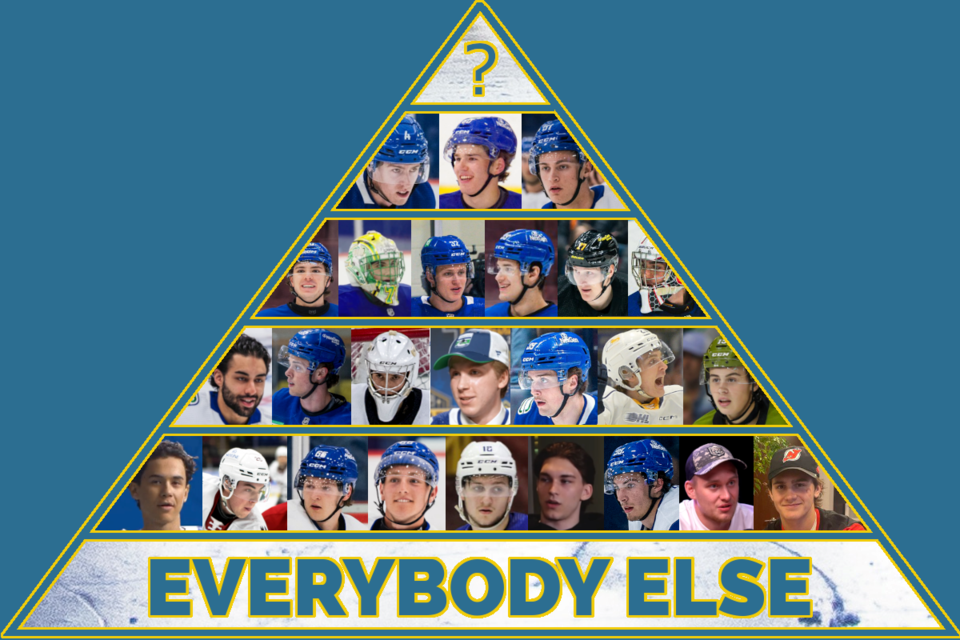
It may seem harsh, but most NHL prospect pools are full of players with extremely long odds of ever playing in the NHL.
That’s nothing against those prospects, who still have a chance. With a lot of hard work, they could still make it, but they have further to go than most.
For the Canucks, that includes Aiden Celebrini, Daimon Gardner, and Basile Sansonnens, who are perhaps the most likely candidates to climb to one of the higher tiers on the pyramid next year.
Of course, those three were also the same prospects I mentioned as having potential to break out of Tier 6 last year, and they haven’t done it yet.



